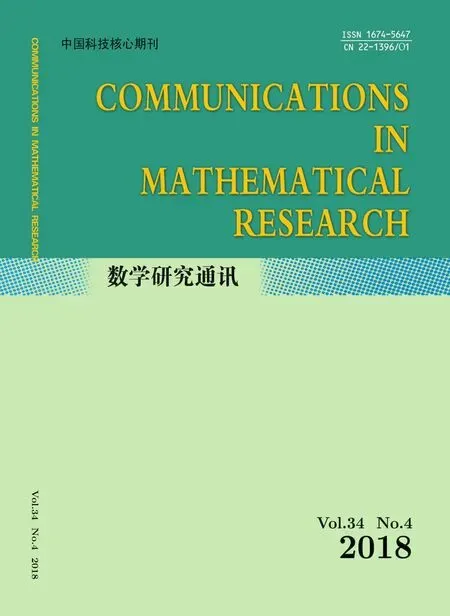Coefficient Estimates for a Subclass of Bi-univalent Strongly Quasi-starlike Functions
Li Zong-taoand Guo Dong
(1.Department of Mathematics Teaching,Guangzhou Civil Aviation College,Guangzhou,510403)
(2.Foundation Department,Chuzhou Vocational and Technical College,Chuzhou,Anhui,239000)
Communicated by Ji You-qing
Abstract:The aim of this paper is to establish the Fekete-Szeg¨o inequality for a subclass of bi-univalent strongly quasi-starlike functions which is defined in the open unit disk.Furthermore,the coefficients a2and a3for functions in this new subclass are estimated.
Key words:bi-univalent function,bi-univalent strongly quasi-starlike function,coefficient estimate,subordination
1 Introduction
Let H denote the class of functions of the form

which are analytic on the open unit disk U={z:|z|<1}.
Let S denote the subclass of H consisting of univalent functions in U.Also,let S?,C and K denote,respectively,the well-known subclasses of H consisting of univalent functions which are starlike,convex and close-to-convex.
Further,let S?(α)and C(α)be the subclasses of S consisting of starlike functions of order α and convex functions of order α respectively.Their analytic descriptions are

In 1933,Fekete and Szeg¨o[1]showed that for f ∈ S given by(1.1)

In[2],Liu defined the class T(β):Let f(z)∈ H,0< β≤ 1.If

then f(z)∈ T(β)is called strong quasi-starlike function of order β.
The well-known Koebe’s one-quarter theorem asserts that every function f ∈ S has an inverse f?1,defined by

A function f(z)∈ H is called bi-univalent if only if both f and f?1are normalized univalent functions on U.The class of bi-univalent functions is denoted by Σ.Lewin[3]first introduced the class of bi-univalent functions and showed that|a2|≤1.51.Since then,many different authors investigated the subclasses of the class of bi-univalent functions and obtained the upper bound of|a2|or|an|(n>2)(see[4]–[10]).
Let

which is analytic on the open unit disk U={z:|z|<1}.If the following conditions are satisfied:

where 0≤ α <1,G=g?1,then g(z)is called the bi-univalent starlike analytic function of order α.The class of bi-univalent starlike analytic functions of order α is denoted by(α).Similarly,we defined a new class of analytic functions:Let 0<β≤1,f(z)=z+such that

where h=f?1,G=g?1,then f(z)is called bi-univalent strong quasi-starlike function of order β.The class of bi-univalent strong quasi-starlike functions of order α is denoted by(β).
In this paper,we study the coefficient estimates and the Fekete-Szeg¨o inequality of the functions in the class of bi-univalent strong quasi-starlike functions of order α.To derive our main result we use the following well known lemmas.
Lemma 1.1[9]Let g(z)=z+b2z2+b3z3+···be analytic in U.If g(z)∈S?Σ(α),then

Lemma 1.2[10]Let g(z)=z+b2z2+b3z3+···be analytic in U.If g(z)∈S?Σ(0),then

Lemma 1.3[11]Let p(z)=1+p1z+p2z2+p3z3+···be analytic in U.If Re{p(z)}>0,then

2 Important Results and Proofs
Theorem 2.1 If f(z)∈ TΣ(β)(0< β ≤ 1),then

Proof. Suppose that f(z)∈ TΣ(β).It follows that

where

From(1.1),(1.2)and(2.1)–(2.6),we have

From(2.7)and(2.9),we have

By using Lemmas 1.1 and 1.3 and(2.12),we have

By using Lemmas 1.1 and 1.3,(2.11)and(2.13),we have

By using Lemmas 1.1 and 1.3 and(2.14),we have

Adding(2.8)to(2.10),we have

By using Lemma 1.3 and(2.16),we have

By using Lemmas 1.1 and 1.3 and(2.19),we have

From(2.15)–(2.17)and(2.20),we get

By using Lemmas 1.1,1.2 and 1.3 and(2.8),we have

This completes the proof of Theorem 2.1.
Theorem 2.2Let f(z)∈ TΣ(β)(0< β≤ 1,μ∈R).Then

Proof.From(2.8)and(2.18),we have

By using Lemmas 1.1 and 1.3 and(2.11),we have

Thus,by using Lemma 1.2,we complete the proof.
 Communications in Mathematical Research2018年4期
Communications in Mathematical Research2018年4期
- Communications in Mathematical Research的其它文章
- Boundedness of Marcinkiewicz Integrals in Weighted Variable Exponent Herz-Morrey Spaces
- Location of Zeros for the Weak Solution to a p-Ginzburg-Landau Problem
- Hermite-Hadamard Type Fractional Integral Inequalities for Preinvex Functions
- Partial or Truncated Sharing Values of Meromorphic Functions with Their Shifts
- The Twisted Transfer Variety
- Planar Cardinal Spline Curves with Minimum Strain Energy
